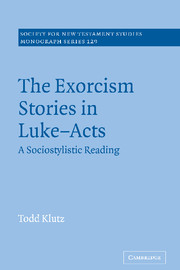Book contents
- Frontmatter
- Contents
- Acknowledgements
- List of abbreviations
- Introduction
- 1 Sociostylistics and the exorcism in Luke 4.33–37
- 2 Purity and the exorcism in Luke 8.26–39
- 3 Discipleship and the exorcism in Luke 9.37–43a
- 4 Paul, Jewish identity, and the exorcism in Acts 16.16–18
- Conclusion
- Bibliography
- Index of sources discussed
- Index of names and subjects
2 - Purity and the exorcism in Luke 8.26–39
Published online by Cambridge University Press: 22 September 2009
- Frontmatter
- Contents
- Acknowledgements
- List of abbreviations
- Introduction
- 1 Sociostylistics and the exorcism in Luke 4.33–37
- 2 Purity and the exorcism in Luke 8.26–39
- 3 Discipleship and the exorcism in Luke 9.37–43a
- 4 Paul, Jewish identity, and the exorcism in Acts 16.16–18
- Conclusion
- Bibliography
- Index of sources discussed
- Index of names and subjects
Summary
To a degree which many interpreters have underestimated at their peril, the Synoptic tradition of the Gerasene demoniac (Luke 8.26–39; par. Matt. 8.28–34; Mark 5.1–20) is an interpretative mine-field. The multiplicity of demonic powers that possess the man from Gerasa (Luke 8.27, 30–33), for instance, has been taken by some interpreters as evidence that the man was suffering from multiple personality disorder, a diagnosis that imposes a modern medical category on the ancient Mediterranean world-view of the text and requires Jesus to heal an illness which comparable folk healers probably never heal. The same feature, moreover, in conjunction with the demons' disclosure of their collective name as ‘Legion’ (Luke 8.30), has enticed several other analysts into interpreting the story as a repudiation of ‘the Roman military garrison’, a reading which overlooks the ultimately intertextual function of the story's military lexis and underestimates the importance of Jewish systems of impurity in the assumed context of culture. And the request by Jesus for the demonic power's name (Luke 8.30) has led still other interpreters to worry about how Jesus' method of exorcism can escape being viewed as less ‘Christian’ than ‘magical’, a problem that dissolves as soon as the distinction between ‘magic’ and ‘Christianity’ (or religion) is recognised as less substantive than perspectival.
But more importantly, these kinds of difficulties and the desire to solve them have become so distracting in scholarly commentary on this story that several important aspects of the text's style and cultural context have suffered neglect.
- Type
- Chapter
- Information
- The Exorcism Stories in Luke-ActsA Sociostylistic Reading, pp. 82 - 151Publisher: Cambridge University PressPrint publication year: 2004



